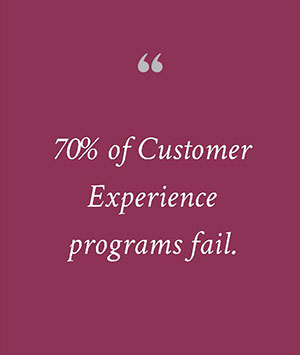
We have all heard the proverb “It takes a village to raise a child.” It means that an entire community of people must provide for and interact positively with children for those children to experience and grow in a safe and healthy environment. The same holds true for customer experience programs—it takes an entire organization to nourish and support a CX vision and strategy to truly become customer-centric.
It is estimated that at least 70% of CX programs fail. Simply put, CX programs fail because they are not supported by the entire organization. Great CX vision and strategies have been created to only to wither and die on the vine due to lack of nourishment and care. There are numerous obstacles that sidetrack the success of a CX program. In our experience, these are some of the most common.
1. Lack of Ownership, Support and Resources
There must be a single owner—a person responsible for success or failure. Recent research found that 53% organizations don’t have a dedicated CX leader. Further, only 23% have a leader that reports to the CEO, a necessary requirement to drive organizational change. CX programs require a strategic vision and leadership from C-level executives. Executive support is critical to providing organization-wide perspective to align department leaders and break down silos.
Multi-million-dollar budgets aren’t required, but a dedicated CX budget and dedicated CX team are required—CX cannot be a part-time responsibility.
2. Siloed Organization
Customers interact with companies horizontally, that is across the entire organization either directly or indirectly, making CX the leader of cross-functional collaboration.
Simply telling cross-functional teams to work together does not work. Breaking down silos often requires a fundamental change to culture and employees’ mindsets and behaviors.
- Common CX vision
- Have cross-functional teams work together on specific customer interactions with a customer focus
- CX governance teams
3. Not Seen as Transformational
In order for an organization to become truly customer-centric requires a transformation. It entails rethinking all aspects of a business. Too often, CX is seen as a program to improve OSAT, NPS or other soft measures. These types of programs are simply looking to improve the experience by removing dissatisfaction. A tactical focus is a foundational component to CX programs, but it only gets you to consistently meeting customers’ expectations, not creating differentiated experiences. These activities tend to provide a faster ROI and increase in KPIs; however, they are quickly completed and turn into measurement and maintenance
programs.
To become customer-centric and deliver financial value requires a fundamental shift in the employee mind-set and behaviors along with operational and IT improvements—only with organizational change can a business provide a differentiated experience that adds bottom line value.
Any transformation effort requires leadership, focus, investment, and commitment.
4. One Size Fits All Approach
CX transformation cannot be achieved using a one-size-fits all. An understanding of customer value is necessary to create targeted experiences based on their needs and profitability to the business.
- While all customers have bottom-line value, 80% of revenue is generated by 20% of the customer base (Pareto Principle). Additionally, there are customers that have strategic value beyond their own profitability – their social impact and the ability to influence others.
- These high impact customers expect to be treated differently from mass customers. They require an experience that creates a long-lasting, mutually beneficial relationship that maximizes their value.
5. No Link to Business Outcomes
If a CX program is not tied to measurable business objectives it will suffer the same fate as other “bright shiny object” initiatives – started with great focus and enthusiasm, eventually abandoned when the ROI cannot be proven.
In order to demonstrate the value of a CX program, a balanced scorecard should be created, with employee engagement, early performance indicators, and business outcomes (i.e., increased revenue, decreased churn).
The Five Obstacles to CX Success
- Lack of ownership, support, and resources
- Siloed organization
- Not seen as transformational
- One size fits all approach
- No link to business outcomes

CX programs are transformational, and transformations are not easy. Change is a personal choice for every employee; if it’s going to stick, your program needs to understand the employee mind-set and the behaviors they need to exhibit to deliver your future state experience. Your efforts need to be focused on making it personal for each employee.
Successful transformations require the entire organization. Ensure you have an accountable leader and the dedicated resources required. Develop a plan that aligns the organization to ensure they remain focused not only on the activities but also on the business outcome.